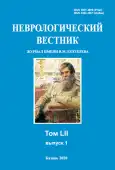Levels of neurocognitive response in the situation of organic brain damage of a child as a clinical and psychological problem
- Authors: Turovskaya N.G.1,2
-
Affiliations:
- Volgograd State Medical University
- Volgograd regional children’s clinical psychiatric hospital, (Child and adolescent mental health center)
- Issue: Vol LII, No 1 (2020)
- Pages: 38-42
- Section: Original study arcticles
- URL: https://journals.rcsi.science/1027-4898/article/view/16471
- DOI: https://doi.org/10.17816/nb16471
- ID: 16471
Cite item
Full Text
Abstract
Aim. The article discusses the results of a psychological study of the development of mental functions in children with convulsive paroxysms in the anamnesis. In order to identify common patterns of mental dysontogenesis in children with cerebral organic pathology, the data obtained are compared with the results of other studies.
Methods. As experimental research methods, methods of neuropsychological diagnosis of higher mental functions in children were used (Tsvetkova, 2002), the diagnostic complex “Forecast and prevention of learning problems at school” (Yasyukova, 2002). Statistical analysis was performed using the SPSS statistical analysis software.
Results. The results of the study showed that the early onset of seizures in children is combined with impaired auditory perception, short-term speech memory, visual linear thinking and motor awkwardness. The prolonged presence of convulsive paroxysms in the history of a preschool child is associated with the pathology of the development of kinesthetic praxis, as well as speech functions and forms of thinking associated with speech. A significant number of seizures in the history of the disease has a more destructive and total effect on the brain of the child in comparison with the age of onset and the duration of the disease. The data obtained are similar to the results of psychological studies of children with other cerebral organic pathology. Consequently, pathological cerebral processes and conditions of various nature can lead to similar disorders in the development of mental functions, presumably those that are at the time the pathological factor begins in the sensitive period of development. This allows using the concept of “levels of neurocognitive response” in a situation of organic damage to the brain of a child.
Conclusion. The picture of the mental development disorder of children with convulsive paroxysms in the anamnesis is mediated by the age of onset, the duration and massiveness of the disease. Children with various diseases of the central nervous system, presumably, have common patterns of mental dysontogenesis.
Full Text
##article.viewOnOriginalSite##About the authors
Natalya G. Turovskaya
Volgograd State Medical University; Volgograd regional children’s clinical psychiatric hospital, (Child and adolescent mental health center)
Author for correspondence.
Email: turovskayanata@mail.ru
SPIN-code: 7312-7121
Associate of Professor of the General and clinical psychology department; medical psychologist
Russian Federation, 400131, Volgograd, Pavshikh Bortsov str., 1; 400005, Volgograd, Glazkov St., 15А
References
- Ковалёв В.В. Психиатрия детского возраста. М.: Медицина. 1979; 608 с. [Kovalev V.V. Psikhiatriya detskogo vozrasta. (Child psychiatry.) Moscow: Meditsina. 1979; 608 p. (In Russ.)]
- Туровская Н.Г. Психолого-педагогическая реабилитация детей с пароксизмальными состояниями в анамнезе. Коррекционная педагогика: теория и практика. 2018; 2 (76): 32–39. [Turovskaya N.G. The psychological and pedagogical rehabilitation of children with paroxysmal conditions in the anamnesis. Korrektsionnaya pedagogika: teoriya i praktika. 2018; 2 (76): 32–39. (In Russ.)]
- Лассан Л.П. Нейрокогнитивный дизонтогенез и клиническая нейропсихология детского возраста. Клиническая и специальная психология. http://psyjournals.ru/psyclin/2012/n3/55172.shtml (дата обращения: 03.08.2016). [Lassan L.P. Neurocognitive dysontogenesis and childhood clinical neuropsychology. Klinicheskaya i spetsialʹnaya psikhologiya. http://psyjournals.ru/psyclin/2012/n3/55172.shtml (access date: 03.08.2016).]
- Туровская Н.Г. Судорожные пароксизмы как фактор нарушения психического развития детей с преморбидной церебральной органической патологией. Вестн. Волгоградского гос. мед. ун-та. 2014; 4 (52): 91–94. [Turovskaya N.G. Convulsive paroxysms as a factor in the mental development of children with premorbid cerebral organic pathology. Vestnik Volgogradskogo gosudarstvennogo meditsinskogo universiteta. 2014; 4 (52): 91–94. (In Russ.)]
- Туровская Н.Г. Патология памяти в структуре нарушения психического развития у детей с судорожными пароксизмами в анамнезе. Эксперим. психол. 2015; 8 (3): 145–155. [Turovskaya N.G. Memory pathology in the structure of mental development disorders in children with convulsive paroxysms in the anamnesis. Ehksperimentalʹnaya psikhologiya. 2015; 8 (3): 145–155. (In Russ.)] doi: 10.17759/exppsy.2015080313.
- Туровская Н.Г. Нейропсихологическая квалификация особенностей психического развития детей с неэпилептическими пароксизмальными состояниями в анамнезе. Клин. и спец. психол. http://psyjournals.ru/psyclin/2016/n1/Turovskaya.shtml (дата обращения: 03.08.2016). [Turovskaya N.G. Neuropsychological qualification of the features of the mental development of children with non-epileptic paroxysmal conditions in the anamnesis. Klinicheskaya i spetsialʹnaya psikhologiya. http://psyjournals.ru/psyclin/2016/n1/Turovskaya.shtml (access date: 03.08.2016).] doi: 10.17759/cpse.2016050106.
- Туровская Н.Г. Сензитивные периоды и патология развития психических функций у детей с судорожными пароксизмами в анамнезе. Эксперим. психол. 2018; 11 (2): 63–76. [Turovskaya N.G. Sensitive periods and pathology of the development of mental functions in children with convulsive paroxysms in the anamnesis. Ehksperimentalʹnaya psikhologiya. 2018; 11 (2): 63–76. (In Russ.)] doi: 10.17759/exppsy.2018110205.
- Заваденко Н.Н. Гиперактивность и дефицит внимания в детском возрасте. Учебное пособие для студентов высших учебных заведений. М.: Академия. 2005; 256 с. [Zavadenko N.N. Giperaktivnostʹ i defitsit vnimaniya v detskom vozraste. Uchebnoe posobie dlya studentov vysshikh uchebnykh zavedeniy. (Childhood hyperactivity and attention deficit. A study guide for higher education students.) Moscow: Akademiya. 2005; 256 p. (In Russ.)]
- Цветкова Л.С. Методика нейропсихологической диагностики детей. Методический альбом. М.: Педагогическое общество России. 2002; 96 с. [Tsvetkova L.S. Metodika neyropsikhologicheskoy diagnostiki detey. Metodicheskiy alʹbom. (Methods of neuropsychological diagnosis of children. Methodical album.) Moscow: Pedagogicheskoe obshchestvo Rossii. 2002; 96 p. (In Russ.)]
- Ясюкова Л.А. Методика определения готовности к школе. Прогноз и профилактика проблем обучения в начальной школе. Методическое руководство. СПб.: ГМНПП «ИМАТОН». 2002; 208 с. [Yasyukova L.A. Metodika opredeleniya gotovnosti k shkole. Prognoz i profilaktika problem obucheniya v nachalʹnoy shkole. Metodicheskoe rukovodstvo. (Methodology for determining readiness for school. Prediction and prevention of learning problems in primary school: a methodological guide.) Saint Petersburg: GMNPP «IMATON». 2002; 208 p. (In Russ.)]
Supplementary files






